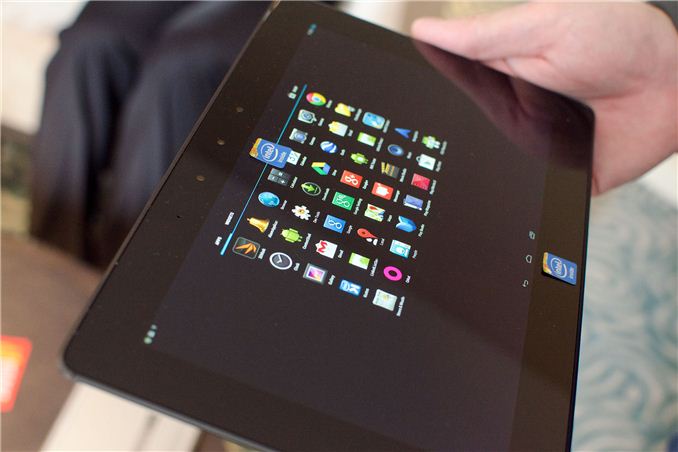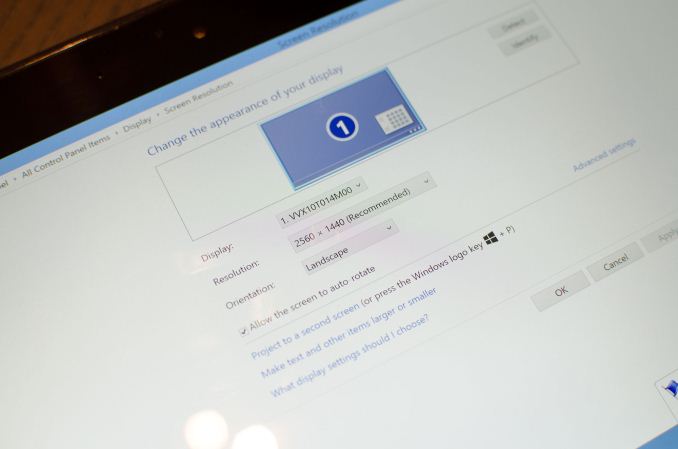Intel Demonstrates Bay Trail-T Running Windows 8 and Android 4.2.2
by Anand Lal Shimpi on June 6, 2013 8:19 PM EST- Posted in
- Tablets
- Intel
- Atom
- Mobile
- Silvermont
- Trade Shows
- SoCs
- Computex 2013

Last month Intel took the covers off its next-generation Atom microarchitecture, codename Silvermont. The first consumer implementation of Silvermont will be Bay Trail, a quad-core SoC for tablets. At Computex, Intel demonstrated its own Bay Trail-T reference platform: a 10-inch 2560 x 1440 tablet, weighing 611 grams and about the thickness of a 3rd/4th generation iPad (Intel wouldn't provide specific measurements, but it felt close).
This reference design is a huge step for low end Windows 8 tablets as well as Intel. If Intel's reference design uses a 2560 x 1440 panel, it's safe to say that at least some of its customers will do the same. The fact that Intel is also showing the reference platform running the latest version of Android means that we'll finally see Intel go after the Android tablet market as well.
It's too early to talk about performance or battery life, but Intel promises that both will be very good.


















25 Comments
View All Comments
jeffkibuule - Thursday, June 6, 2013 - link
It's good to see that high DPI displays won't just be limited to Apple products! And breaking the 1080p barrier too!MonkeyPaw - Thursday, June 6, 2013 - link
High density displays are common for Android. It's the Windows tabs that suffer. Some of that is Clovertrail's fault, since the integrated GPU is pretty sad. There could be some desktop scaling issues at play as well. If we could just see better adoption of Modern, I think we'd see a high DPI breakthrough on all Windows tabs.I'm pretty sure out next PC will be a dockable tablet running either a low voltage AMD or late model Atom CPU.
Gigaplex - Thursday, June 6, 2013 - link
The Modern UI DPI scaling isn't much better.kyuu - Friday, June 7, 2013 - link
I've heard it is much better.inighthawki - Friday, June 7, 2013 - link
Metro is much better and is completely high dpi aware. It is only legacy desktops apps that do not have proper support.B3an - Friday, June 7, 2013 - link
Complete BS. I've used Metro at 720p to way over 2560x1600 and much higher, and it scales perfectly on everything.DanNeely - Friday, June 7, 2013 - link
2560x1440 is large enough for 2:1 integral scaling (to 1280x720) which should allow non hDPI applications to be scaled with fewer artifacts than with various non-integral scaling options.zeo - Friday, June 7, 2013 - link
High density displays are only common on the high end and certain name brand Android devices and they don't make up the majority of the Android market!One reason is because very high PPI increases power consumption considerably. The screen alone increased power consumption by 30% for the 3rd gen iPad for example.
While the other reasons is much higher resolution also puts a much higher load on the system for both CPU and GPU and until recently most ARM devices didn't provide much performance at all.
The latest Cortex A15 SoCs are only rivaling Intel ATOM performance and that's still very low on the PC performance scale!
Devices like the iPad only get away with it because they managed to put in a 50% larger battery and increased the GPU performance with a quad configuration but even then performance doesn't exceed the graphical performance of even a low end AMD APU like the Hondo Z-60...
While for PC's the reasons are because the desktop still doesn't scale well and because on PC's you'll be running far more powerful programs and at higher resolutions you need even greater performance in order to run things like modern games at good enough fps...
Mind that iGPU's are still at best only at the level of a entry level discrete graphic card, with options like the Haswell Iris Pro pushing that maybe to mid range. While you'll need high end discrete graphic card performance to really support gaming on those high resolution displays!
Never mind how all that performance will just kill battery life... So I wouldn't suggest they push it this early...
kiotu - Sunday, June 30, 2013 - link
Interesting point, but how come windows tab performance flaw has something to do with Clovertrail? Windows 8 RT tabs generally powered by nvidia tegra3, and the Windows 8 pro tabs are by intel Core series which I think is a powerhouse for any tablet in comparison. Care to elaborate?hackbod - Thursday, June 6, 2013 - link
Fyi Android introduced higher density displays well before iOS -- Droid was the first one, running Android 2.0, and came out a bit less than a year before the first iPhone with a retina display. :)